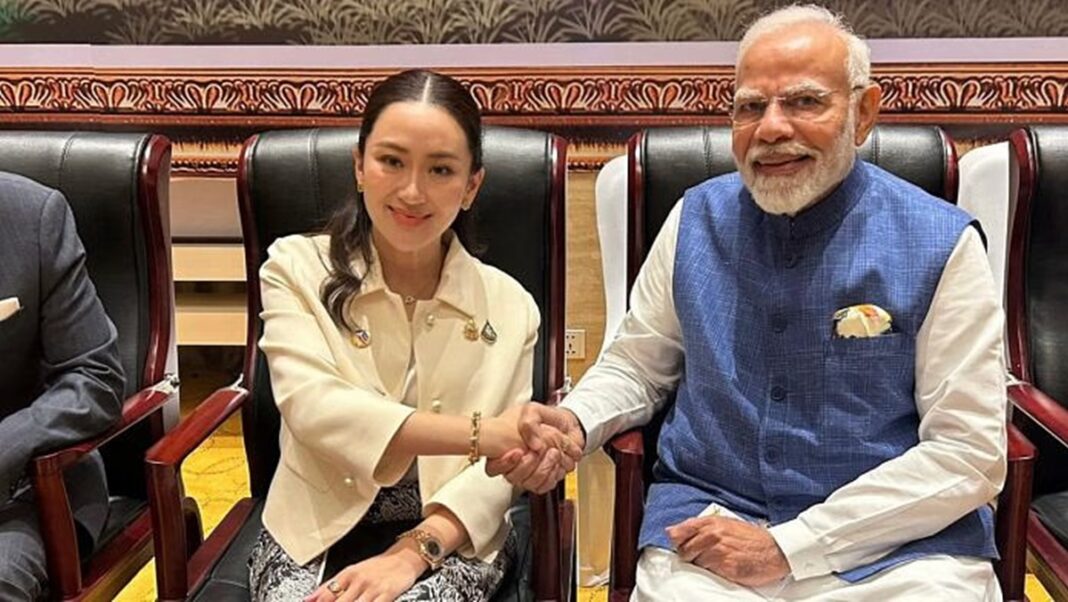X: @vivekbhavsar
In the realm of global diplomacy, not every handshake makes headlines, but some carry the quiet weight of strategic recalibration. Prime Minister Narendra Modi’s recent visit to Thailand may not have generated the political drama often associated with summits involving global heavyweights, yet it marked a crucial step in India’s evolving regional outreach. More than a symbolic appearance, the visit signals Delhi’s intention to deepen engagement with Southeast Asia at a time when global power dynamics are shifting eastward.
While the primary agenda centered around the regional summit in Bangkok, the visit had subtexts that deserve closer scrutiny — India’s strategic convergence with Thailand, its nuanced signaling to ASEAN nations, and the quiet diplomacy at play in PM Narendra Modi’s meeting with Dr. Muhammad Yunus, the Chief Advisor of Bangladesh.
India and Thailand share more than historical and civilisational links; they stand at a maritime crossroads critical to Indo-Pacific stability. Thailand’s geographical location makes it a gateway to ASEAN, while India’s Andaman and Nicobar Islands place it in proximity to the Thai coast. Yet, the potential of this maritime neighborhood has long remained underutilised.
PM Modi’s visit reiterates New Delhi’s desire to transform this relationship from cultural camaraderie into strategic collaboration. Under the umbrella of India’s Act East Policy and Thailand’s Look West Policy, the two nations are aligning their vision across trade, digital connectivity, security cooperation, and infrastructure.
Bilateral trade between India and Thailand has hovered around USD 17 billion, with ambitions to scale further. Thailand’s interest in India’s growing digital economy, pharmaceuticals, and renewable energy sector presents opportunities for deeper economic integration. Modi’s presence in Bangkok also reaffirmed India’s commitment to fast-tracking connectivity projects — particularly the trilateral highway linking India, Myanmar, and Thailand, which has both strategic and commercial implications.
This visit also needs to be understood in the context of India’s engagement with ASEAN — a bloc that remains central to its Indo-Pacific strategy. At a time when China’s influence looms large over the region through its Belt and Road Initiative and increasing naval presence in the South China Sea, India’s diplomatic focus on ASEAN nations such as Thailand sends a subtle but significant message.
India’s push for maritime cooperation, freedom of navigation, and rules-based order echoes the concerns of smaller Southeast Asian states wary of Chinese hegemony. Thailand, which maintains cordial ties with both China and the West, represents a balancing partner for India to amplify its voice in regional forums without appearing overtly confrontational.
On the sidelines of the summit, PM Modi’s meeting with Dr. Muhammad Yunus, the Chief Advisor to Bangladesh’s interim government, offered another important moment. While the political situation in Dhaka remains fluid, India’s diplomatic tone has been measured and constructive.
This interaction was significant for a few reasons. First, it reaffirms India’s long-standing commitment to fostering stability and cooperation with its eastern neighbor, regardless of internal transitions. Second, it reflects India’s preference for quiet diplomacy—focused on connectivity, economic partnership, and people-to-people ties, rather than political posturing.
With regional initiatives such as BBIN (Bangladesh-Bhutan-India-Nepal), cross-border energy trade, and riverine transport projects, India and Bangladesh’s development-focused collaboration continues to mature. Dr. Yunus, known globally for championing social business and grassroots innovation, also symbolises a softer, people-centric diplomatic track that complements traditional government-to-government engagement.
Modi’s visit to Thailand and his interactions in Bangkok reflect a broader Indian strategy — a recalibration of its eastern flank through partnerships rooted in shared interests, mutual respect, and regional stability. While much attention in Indian foreign policy remains fixed on its western front — from Pakistan to the Gulf and West Asia — it is the eastern corridor, extending from the Bay of Bengal to the South China Sea, that is quietly gaining traction.
India’s outreach to Thailand, a rising middle power in ASEAN, and Bangladesh, a growing economic hub in South Asia, is part of a layered approach: counterbalance China, strengthen regional alliances, and secure long-term connectivity goals.
In an age where military posturing often steals the spotlight, diplomacy anchored in development, dialogue, and trust-building offers a quieter but more durable path. Modi’s Bangkok visit is a reminder that sometimes, foreign policy success lies not in headline-grabbing declarations, but in the consistent stitching together of regional relationships — one meeting, one corridor, and one cultural bridge at a time.






